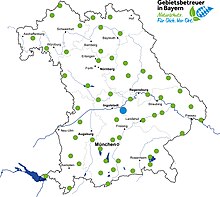Ranger (protected area supervisor)
The original meaning of ranger (from English range for "area, area") is "guardian of a landscape area". In terms of content, the profession emerged from that of the gamekeeper . In North America, the employees of the National Park Service , the United States Forest Service , Parks Canada and some other, also sub-national and municipal authorities are called rangers. Since the profession is highly valued there and the term ranger is also associated with positive associations in Europe, it was adopted into German.
history

In 1872 the first national park was designated in the USA , the Yellowstone National Park . Eight years later, Harry Yount started his work there as the world's first national park ranger.
Ranger in Germany
As full-time supervisors of a protected area, rangers work in Germany in particular in national natural landscapes (national parks, biosphere reserves , nature parks ). In addition, they work in nature reserves , in biological stations , for municipalities , for foundations or even as a freelancer . Depending on the region , they are also called nature guardians , national park warriors or nature conservation officers .
Areas of responsibility
The ranger sees himself as a mediator between man and nature. This results in the following fields of activity for him:
- Visitor support: Using the means of interpretation , he conducts excursions , guided tours, project days, natural history school and educational programs and major events.
- Awareness-raising and public relations work : He passes on information to visitors and the local population, conducts lectures and information stands and advises land users on contractual nature conservation measures .
- Maintenance and repair work: He carries out planting, hedge and tree pruning , meadow maintenance and species protection measures, controls the visitor facilities and is responsible for hazard protection, waste disposal, and machine and equipment maintenance.
- Scientific investigations: He carries out monitoring programs for animal and plant species, supports research projects, takes samples, records data and evaluates them.
- Monitoring and protection: He controls compliance with protective regulations, supports the police , fire brigade and authorities and is trained in first aid .
Professional qualification
The ranger represents the first non-academic nature conservation profession in Germany. The state recognition of the profession took place on March 14, 1998 with the entry into force of the Further Education Ordinance ( Federal Law Gazette No. 14 of March 13, 1998) for certified nature and landscape conservationist . It regulates the professional qualification for the activity as a ranger nationwide. The prerequisite for admission to the examination is origin from a “green” profession. In addition, there is a side entry clause that enables people with other professional qualifications to practice the profession. This means that the necessary knowledge can also be acquired and proven in other ways.
Area support in Bavaria
In 1997, the foundation stone for full-time care of ecologically sensitive areas was laid in Bavaria with the establishment of a corresponding funding area at the Bavarian Nature Conservation Fund. Since no state bodies could be created for financial reasons, a model was developed in which municipalities, nature conservation or landscape conservation associations act as sponsors and employers. The technically qualified area supervisors in currently 55 areas of Bavaria (e.g. Allgäu Alps , Ammersee and sandy grassland areas near Erlangen ) work in the field of public relations and environmental education also in monitoring rare and endangered species as well as in area management (e.g. B. visitor management and initiation of landscape conservation measures). In addition to the 55 supervised areas, there are two full-time beaver advisors who work across Bavaria . The first such area supervisor was set up for the nature reserves of the Ammersee, his position is based at the State Association for Bird Protection in Bavaria .
The project area manager in Bavaria was recognized as a UN Decade Project in 2017 because it is an important building block for the preservation of biodiversity in Bavaria. The project thus also plays an important role in the implementation of the European Fauna-Flora-Habitat Directive in the respective areas.
Ranger in Switzerland
Rangers in Switzerland are organized differently depending on the canton or municipality and have variable tasks. Most of them work in nature reserves or parks and have information and supervision tasks. Other names are park rangers, protected area managers or nature conservation officers.
education
The profession of ranger is not federally recognized in Switzerland. The Wald educational center in Lyss offers a one-year, part-time course to become a ranger. The advanced training is open to everyone who has completed basic training in a natural occupation and has two years of professional experience.
organization
The rangers in Switzerland are organized in the professional association Swiss Rangers. The association was founded in Lyss in 2008. It includes around 230 people from all parts of the country.
See also
literature
- Manfred Lütkepohl: Brandenburg nature watch . In: National Park . No. 134 , 2006, p. 28-31 .
- Hannes Krauss and Georg Schlapp: Area supervisors in Bavaria . In: Nature and Landscape . No. 6 , 2013, p. 242-250 .
Web links
- German interest group of rangers
- Website of the project area manager in Bavaria
- Swiss professional association for rangers, park rangers and protected area managers
Individual evidence
- ↑ Federal Law Gazette, No. 14 of March 13, 1998 (accessed on March 7, 2010; PDF; 236 kB)
- ↑ Augsburger Allgemeine: Tell me where the blue flower is , September 4, 2014.
- ↑ UN Decade of Biological Diversity | Area manager in Bavaria: nature conservation. To you. On site. Retrieved November 12, 2017 .
- ↑ H. Krauss, et al .: Area manager and Natura 2000. (PDF) In: ANLiegen Natur. Bavarian Academy for Nature Conservation and Landscape Management, p. 6 , accessed on November 12, 2017 .
